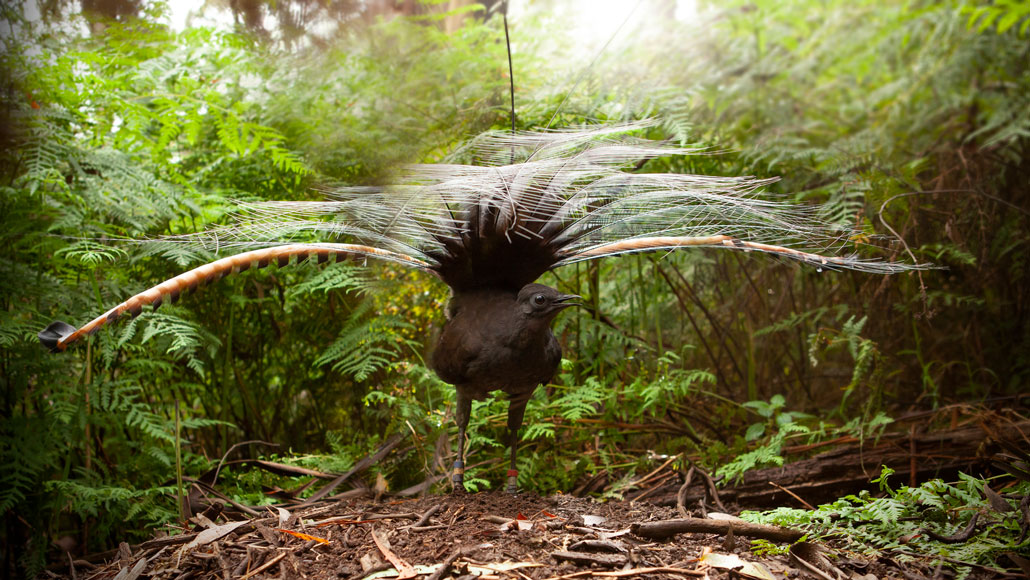
A male superb lyrebird (pictured) can not only copy the songs of individual birds, but those of entire multispecies groups, new research suggests.
Alex Maisey
You might be able to do a mean celebrity impression or two, but can you imitate an entire film’s cast at the same time? A male superb lyrebird (Menura novaehollandiae) can, well almost. During courtship and even while mating, the birds pull off a similar feat, mimicking the calls and wingbeat noises of many bird species at once, a new study shows.
The lyrebirds appear to be attempting to recreate the specific ecological soundscape associated with the arrival of a predator, researchers report February 25 in Current Biology. Why lyrebirds do this isn’t yet clear, but the finding is the first time that an individual bird has been observed mimicking the sounds of multiple bird species simultaneously.
The uncanny acoustic imitation of multispecies flocks adds a layer of complexity to the male lyrebird’s courtship song yet unseen in birds and raises questions about why its remarkable vocal mimicry skills, which include sounds like chainsaws and camera shutters, evolved in the first place.
Superb lyrebirds — native to forested parts of southeastern Australia — have a flair for theatrics. The males have exceptionally long, showy tail feathers that are shaken extensively in elaborate mating dances (SN: 6/6/13). The musical accompaniment to the dance is predominantly a medley of greatest hits of the songs of other bird species, the function of which behavioral ecologist Anastasia Dalziell was studying via audio and video recordings of the rituals.
“When you hear lyrebirds, you hear this very loud, very lyrical, dramatic delivery of mimicry of lots of different species of Australian birds,” says Dalziell, of the University of Wollongong in Australia. The strident calls of kookaburras and parrots are common targets. “But when I started to record [lyrebirds] in detail and for very long periods of time, I realized that every now and then they did something completely different.”
The lyrebirds would transition into a shorter, quieter song made of fluttering noises and scattered chirping. Dalziell thought it sounded like the mixed species “mobbing flocks” she’d experienced in her fieldwork, where prey birds spot a predator and aggregate into a loud, aggressive contingent that attempts to drive away the threat.
Mimicking a mob
In this recording – taken in Sherbrooke Forest, in Victoria, Australia – a throng of several species of songbirds have aggregated into a noisy mob in response to a threat. Such “mobbing flocks” harass bird predators like snakes and hawks and are a reliable cue of such animals’ presence.
A flock sounds the alarm
In this recording, a male superb lyrebird ends its complicated courtship song and dance with an uncanny imitation of a raucous mobbing flock. By mimicking the simultaneous, agitated sounds of multiple species of songbirds, the male might be simulating a scenario of predatory peril.
A lyrebird simulates the scene
When Dalziell and her colleagues analyzed the acoustic signatures of the lyrebirds’ strange songs and compared them to those of actual mobbing flocks, the similarities were striking. It was an accurate enough impression to fool other birds too. When the team played back the lyrebird’s fake flock noises in the wild, songbirds were attracted to the speakers to a similar degree as when the speakers played audio from a real mobbing flock. But the songbirds largely ignored the speakers when they played the lyrebird’s typical mimicked melodies.
“Mimicking the calls and the wingbeats of a flock of small songbirds while they are mobbing predators is quite convincing to my human ears,” says Çağlar Akçay, a behavioral ecologist at Koç University in Istanbul not involved with this research. The findings, he says, are part of a “very cool study on a very cool animal.”
While the lyrebirds could be mimicking a mobbing flock, they might not be doing so to mimic the mobbing intention itself, says Dominique Potvin, an ecologist at the University of the Sunshine Coast in Queensland, Australia, also not involved with this research. Replicating mobbing calls, she says, could just be a difficult vocal feat meant to impress a mate.
Some clues about why the males sing these mobbing songs might come from their timing. Video recordings reveal that the males make the calls right at the end of a courtship display and during mating. The flock mimicry may not be about wooing a female, but deceiving her into believing a predator is nearby, Dalziell says. Such a tactic by this “master illusionist” might enhance the chance of a successful mating by keeping the female close.
Akçay is skeptical of this explanation. “Intuitively, it seems that it wouldn’t be exactly adaptive for a female to return to an area — to copulate no less — if she is under the impression that there is a predator around,” he says.
The findings generate lots of new avenues for research, notes Dalziell. Determining if females react to the simulated mobbing flock similarly to the real version might be one way to test the deception idea.





